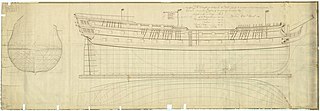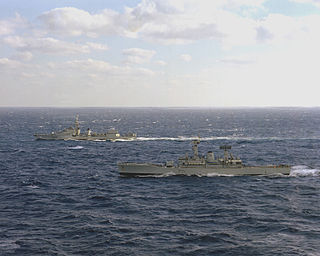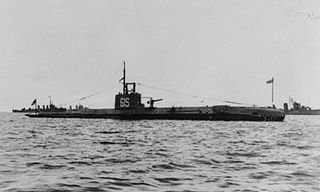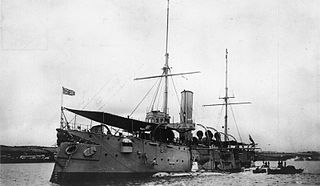
Plymouth Sound, or locally just The Sound, is a deep inlet or sound in the English Channel near Plymouth in England.

Scapa Flow is a body of water in the Orkney Islands, Scotland, sheltered by the islands of Mainland, Graemsay, Burray, South Ronaldsay and Hoy. Its sheltered waters have played an important role in travel, trade and conflict throughout the centuries. Vikings anchored their longships in Scapa Flow more than a thousand years ago. It was the United Kingdom's chief naval base during the First and Second World wars, but the facility was closed in 1956.

HMS Colossus was a 74-gun third-rate ship of the line of the Royal Navy. She was launched at Gravesend on 4 April 1787 and lost on 10 December 1798. During her years of service she participated in the Battle of Groix, the Battle of Cape St Vincent, and the Battle of the Nile. While carrying wounded from the latter, she was wrecked at the Isles of Scilly. The wreck is a Protected Wreck managed by Historic England.

HMS Scylla (F71) was a Leander-class frigate of the Royal Navy (RN). She was built at Devonport Royal Dockyard, the last RN frigate to be built there as of 2016. Scylla was commissioned in 1970, taken out of service in 1993 in accordance with Options for Change, and sunk as an artificial reef in 2004 off Whitsand Bay, Cornwall.

HMAS Swan, named for the Swan River, was a River-class destroyer escort of the Royal Australian Navy (RAN). Constructed in Melbourne following the loss of HMAS Voyager, Swan entered service in 1970.
HMT Warwick Deeping (H136) was a naval trawler of the British Royal Naval Patrol Service during World War II, sunk off the Isle of Wight in October 1940.

HMS Royal George was a ship of the line of the Royal Navy. A first-rate with 100 guns on three decks, she was the largest warship in the world at the time of her launch on 18 February 1756. Construction at Woolwich Dockyard had taken ten years.

HMS Swordfish (61S) was a first-batch S-class submarine built for the Royal Navy during the 1930s. Commissioned in 1932, she was given the pennant number 61S and was assigned to the 2nd Submarine Flotilla.

HMS Pelorus was an Algerine-class minesweeper built for the Royal Navy (RN) during World War II. Upon completion, the ship became the flotilla leader of the 7th Minesweeper Flotilla, clearing mines off the east coast of England. In June 1944, the flotilla was assigned to sweep one of the beaches during the Normandy landings until she struck a mine the following month. After her repairs were completed, Pelorus was reassigned to the English Channel and the 6th Minesweeping Flotilla. The flotilla was transferred to the Indian Ocean in 1945 and spent some time escorting convoys. They participated in Operation Collie, a bombardment of Japanese positions in the Nicobar Islands, in July and then swept the Strait of Malacca and the approaches to Singapore in August.

HMS Port Napier was a British motor ship that was designed and laid down as a civilian cargo ship but completed in 1940 as an auxiliary minelayer for the Royal Navy. An engine room fire caused an explosion that destroyed her in November 1940. Her remains in Loch Alsh in Scotland are now a recreational wreck diving site.

HMS Thames was a Mersey-class protected cruiser built for the Royal Navy (RN) in the 1880s. The ship was placed in reserve upon her completion in 1888 and was converted into a submarine depot ship in 1903. She was sold out of the navy in 1920 and was purchased by a South African businessman to serve as a training ship for naval cadets under the name SATS General Botha. The ship arrived in South Africa in 1921 and began training her first class of cadets in Simon's Town the following year. General Botha continued to train cadets for the first several years of World War II, but the RN took over the ship in 1942 for use as an accommodation ship under her original name. She was scuttled by gunfire in 1947 and is now a diveable wreck.

USS Mizpah (PY-29) was a United States Navy patrol yacht. Constructed in 1926, the vessel was constructed as the pleasure yacht Savarona. In 1929 it was renamed Allegro and then Mizpah for use on the Great Lakes. The vessel was acquired by the United States Navy in 1942 and converted to a warship and commissioned the same year. Mizpah served as a convoy escort along the United States East Coast before becoming a school ship in 1944. Following the end of the war, the vessel returned to private operation in 1946 until 1967 when Mizpah was laid up with a broken crankshaft at Tampa, Florida. An attempt to save the ship proved futile and Mizpah was scuttled off the coast of Florida as an artificial reef in 1968. The wreck is now a popular dive site.

Sinking ships for wreck diving sites is the practice of scuttling old ships to produce artificial reefs suitable for wreck diving, to benefit from commercial revenues from recreational diving of the shipwreck, or to produce a diver training site.
HMT Elk was a 181-ton former fishing trawler built in 1902. She served in the Royal Navy in World War II, until sunk without loss of life having hit a mine off Plymouth in November 1940.
Richard James Vincent Larn, OBE is a retired Chief Petty Officer in the Royal Navy, a businessman and maritime history writer who is widely regarded as one of Britain's leading historic shipwreck experts.

SAS Transvaal was one of three Loch-class frigates in the South African Navy (SAN). She was built as HMS Loch Ard (K602) for the Royal Navy during World War II, but was transferred to the SAN in 1944 before completion and renamed as HMSAS Transvaal. The ship was completed shortly after the German surrender in May 1945 and did not participate in the war.
The following index is provided as an overview of and topical guide to Wikipedia's articles on recreational dive sites. The level of coverage may vary:

Recreational dive sites are specific places that recreational scuba divers go to enjoy the underwater environment or for training purposes. They include technical diving sites beyond the range generally accepted for recreational diving. In this context all diving done for recreational purposes is included. Professional diving tends to be done where the job is, and with the exception of diver training and leading groups of recreational divers, does not generally occur at specific sites chosen for their easy access, pleasant conditions or interesting features.














